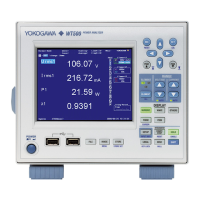
Do you have a question about the YOKOGAWA WT500 and is the answer not in the manual?
| Type | Power Analyzer |
|---|---|
| Power Measurement | Active, Reactive, Apparent Power |
| Frequency Range | DC, 0.5 Hz to 100 kHz |
| Display | LCD |
| Channels | 1 to 4 |
| Voltage Measurement Range | 1.5 V to 1000 V (depending on the sensor) |
| Basic Accuracy | 0.1% |
| Harmonic Analysis | Up to 50th |
| Interfaces | Ethernet |
Identifies and describes the physical controls and connectors on the instrument.
Explains the functions of panel keys and how to navigate setup menus.
Details the layout and elements of the instrument's screen display.
Overview of the WT500's system configuration and internal block diagram.
Explains available measurement functions and the concept of measurement periods.
Details various measurement conditions like wiring systems and input element configurations.
Details how to display and interpret voltage and current waveforms.
General precautions for safe and proper handling of the instrument.
Guidelines for proper installation environment and conditions.
Instructions for safely connecting the power cord and ensuring proper grounding.
Critical safety warnings and guidelines for wiring connections to avoid shock.
Steps to reset all settings to factory defaults.
Identifies panel keys and setup menus relevant to measurement conditions.
How to select the appropriate wiring system for measurement.
How to set voltage and current measurement ranges for direct input.
How to set the measurement period and synchronization source.
Choosing between exponential and moving averages for measurements.
How to set the crest factor for measurement range adjustment.
Identifies panel keys and setup menus relevant to power measurement.
Instructions on how to view and modify numeric measurement data displays.
Details on the integration feature, including modes and operations.
Guide for creating and configuring custom measurement equations.
Identifies panel keys and setup menus relevant to harmonic measurement.
How to select and change displayed numeric data items for harmonic analysis.
Procedure for selecting a PLL source for stable harmonic analysis.
How to specify the minimum and maximum harmonic orders for measurement.
How to display harmonic data as bar graphs and use cursors for measurement.
Identifies panel keys and setup menus relevant to waveform display.
Procedure for displaying voltage and current waveforms on the screen.
Guide on configuring trigger mode, source, slope, and level for waveform capture.
How to use cursors to measure values on displayed waveforms.
Identifies panel keys and setup menus relevant to trend display.
Procedure for displaying trend graphs of measurement data over time.
Procedures for selecting measurement functions and harmonic orders for trend display.
How to use cursors to measure values on displayed trends.
Identifies panel keys and setup menus relevant to data storage.
How to select manual, real-time, or integration synchronization storage modes.
Configuration of storage parameters like count, interval, and scheduled times.
How to select the storage medium (USB, RAM) and directory.
Procedure for starting, stopping, and resetting the numeric data storage operation.
Identifies panel keys and setup menus relevant to saving and loading data.
Procedures for saving setup parameters, waveform data, and numeric data.
Procedures for loading saved setup parameters and viewing file properties.
Instructions for deleting files from storage media.
Identifies panel keys and setup menus relevant to the Ethernet interface.
Instructions for connecting the WT500 to a PC via a network (hub/router).
Steps to configure DHCP, IP address, subnet mask, gateway, and DNS settings.
How to access the WT500's internal storage via FTP from a PC.
Identifies panel keys and setup menus relevant to VGA output and other features.
Procedure for performing zero-level compensation for accurate measurements.
How to enable and disable the NULL feature to subtract DC offset.
Instructions for activating key lock and shift lock to prevent accidental operations.
A guide to identifying and resolving common problems and unusual circumstances.
Explains error messages and provides solutions for troubleshooting.
Procedure for performing memory and keyboard self-tests.
How to view instrument details like model, firmware, and option configurations.
Technical specifications related to input terminals and signal conditioning.
Detailed accuracy specifications for voltage, current, and power measurements.
Summary of instrument functions including frequency range, averaging, and integration.
Explains symbols and computation methods for normal measurement functions.
Lists measurement functions and computation methods for harmonic measurements.
Explains computed results for delta computation and related symbols.
Lists the default settings for various instrument parameters.
Shows the default order for displaying numeric data in different display modes.
Explains AC power calculation, apparent power, active power, and power factor.
Explains harmonics in AC power systems and related terminology.
Discusses minimizing power loss effects on measurement accuracy through proper wiring.
Wiring considerations for accurate measurements with high currents.
Explains how stray capacitance affects accuracy and how to minimize it.
Explains the role of the synchronization source in determining the measurement period.
Guidance on selecting the most suitable input signal for synchronization.
Mapping of USB keyboard keys to WT500 functions and characters.
Lists measurement functions and their corresponding operands used in user-defined functions.
Lists user-defined functions F1 to F8 and their parameters.